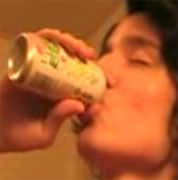
MONDAY, Nov. 30 (HealthDay News) — Tabs on beverage cans — the kind that stay attached once a can is opened — still pose a danger to children, who can swallow the tabs and damage their digestive tract, according to a new study.
About three decades ago, beverage makers starting using what they call stay-tabs instead of pull-tabs, which were believed to pose a swallowing hazard for children and for anyone who stepped on them. But the new finding raises “the possibility that the redesign of beverage cans may not have reduced the number of ingestions,” Dr. Lane F. Donnelly, radiologist-in-chief and director of biodiagnostics at Cincinnati Children’s Hospital Medical Center and the study’s lead author, said in a news release from the Radiological Society of North America.
Swallowing objects, particularly those with sharp edges, can cause injury to the gastrointestinal tract, sometimes requiring surgery.
The study identified 19 youths who had accidentally swallowed a stay-tab and were treated at Cincinnati Children’s between 1993 and 2009. Their average age was 8½ years, but most were teenagers. Only four were younger than 5.
“It is unusual that the majority of cases occurred among teenagers since foreign body ingestion typically occurs in infants and toddlers,” Donnelly said.
Surgery was required in just a few of the 19 cases, the study reported.
A major challenge for doctors in such cases, Donnelly said, is that the beverage can tabs are difficult to see on X-rays. Of the 19 cases in the study, only four of the stay-tabs were visible on X-rays. In each of those four cases, the tab was located in the stomach.
“Clinicians and radiologists should be aware that this does occur,” Donnelly said. “Not seeing the tab on the X-ray does not mean it was not swallowed.”
He said the findings call into question the current design of beverage cans.
“The identification of 19 ingested stay-tabs at a single children’s hospital suggests that such occurrences are not uncommon,” Donnelly said.
The study was scheduled to be presented Monday in Chicago at the annual meeting of the Radiological Society of North America.
More information
The U.S. National Library of Medicine has more about swallowing or inhaling a foreign object.

